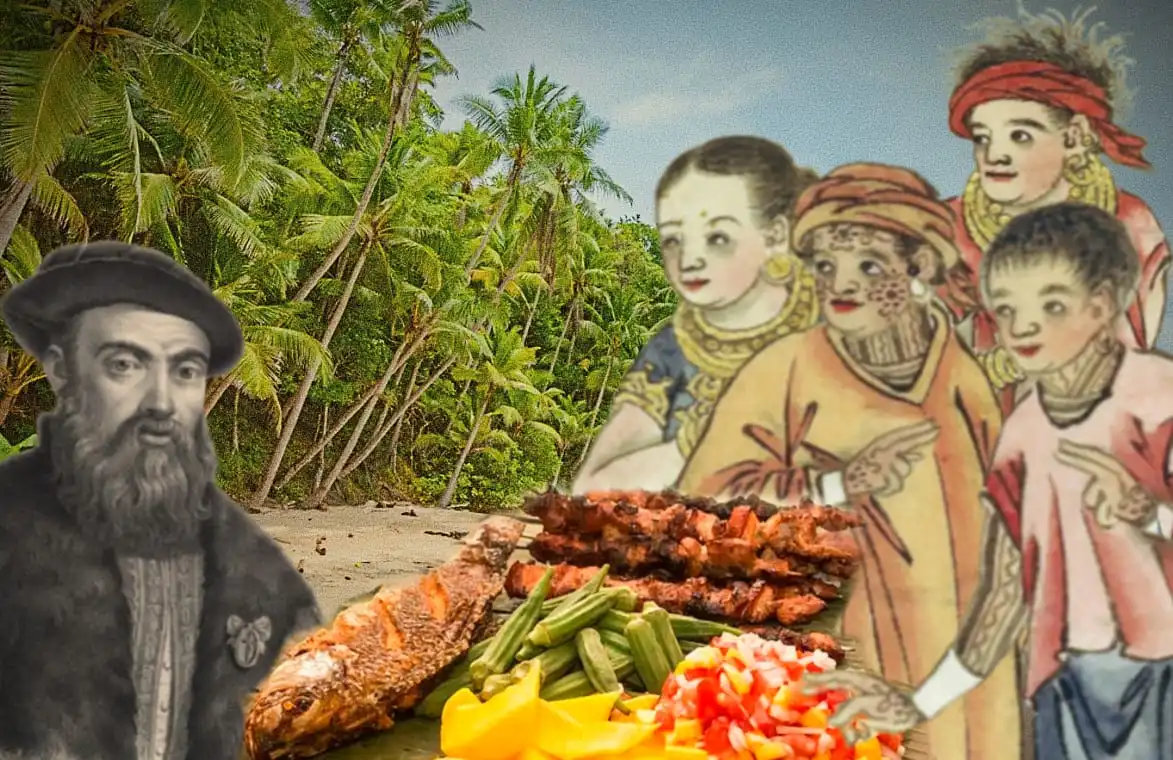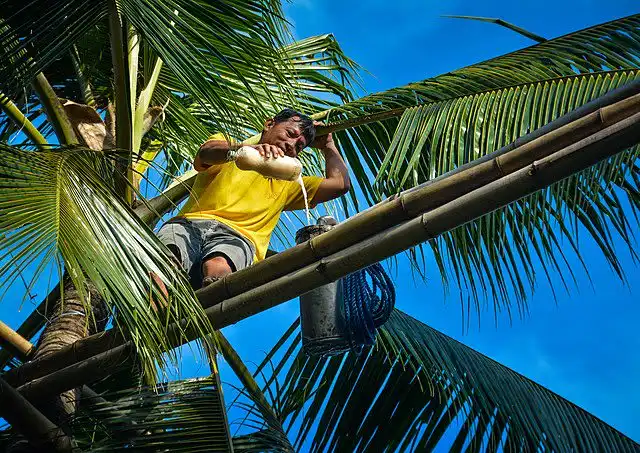
Filipino Food Mukbang with Magellan's Men

What started out as a relaxing Saturday for Ferdinand Magellan and his tired crew was suddenly disturbed by the sound of an incoming boat. Magellan’s fleet had recently landed on the Philippine island now identified as Homonhon and were already at risk of being greeted by another band of suspect seafarers. About a fortnight ago their entourage was burgled by some of the natives of Guam. Now that they were on much distant shores, was an encore about to happen?
Luckily for Magellan, these mariners came not to sack, but to share and snack. One of the crew members, Antonio Pigafetta, a Venetian who joined the Spanish-sponsored Armada de Molucca in search of the famed spice islands via a westward route, wrote an account of that fateful encounter on 18 March 1521 in his travel diary. This journal would later be polished and published as one of the first literary portals into the world of precolonial Philippines in particular and Southeast Asia in general, much to the delight of many curious European minds. But before taking the printers to task, Pigafetta and the others enjoyed the company of these amicable natives who brought with them “some fish, and a vessel of palm wine, which they call in their language Uraca; figs more than a foot long, and others smaller and of a better savour, and two cochos” to exchange with the exhausted crew.
Prior to their arrival in precolonial Philippines, Magellan’s voyage was punctuated by episodes of rebellion, hunger, and desperation. Of the Armada’s original five ships, only three were left at Magellan’s command a year after the fleet left the ports of Spain in 1519: one was lost to a storm, another to desertion. The latter was spurred by mutinous echoes among Magellan’s cast, not exclusively driven by selfish interests, but also amplified by Magellan’s brand of maritime leadership. Apparently, “he did not entirely declare the voyage which he was going to make”, leaving the members confused as to the whole scope of the voyage. His questionable loyalty to the Spanish crown as a native of Portugal, Spain’s chief rival at the time, was also a contentious issue among the Spanish members of the Armada, especially the “the masters and captains of the other ships of his company” who “did not love him”.
As a result, opportunistic fleet officers capitalised on this incertitude to stage their mutinies. Two failed. In the aftermath of the first, Magellan granted clemency to the mutineers, only issuing demotions and severe warnings. He wasn’t too lenient in the second, meting out orders for executions and having two of the chief conspirators marooned on an uninhabited island. This willing display to punish and kill, however, failed to settle seditious intentions. At the southern tip of South America, Magellan and his crew had finally found the strait that would lead them out of the Atlantic and into waters unknown. This strait would later be named after Magellan. Problem was, finding an exit out of this marine maze was as difficult as finding it in the first place. Eager to reach the spice islands as soon as possible, Magellan sent two ships on an advance mission to look for a channel leading out of the labyrinthine strait. Perhaps Magellan failed to make himself clear as one ship went straight back to Spain instead.
When they did find the exit, Magellan decided to hurry out of the strait as they were already way behind schedule, crucially foregoing the need to restock his supplies as that would eat much of their precious time. It was a bold and rather rash decision that may have been influenced by the new waters they found themselves in, because in contrast to the stormy seas they encountered in the Atlantic leg of their odyssey, what confronted them now was a sleepy sea that stretched for unfathomable distances. No one before them, in recorded history at least, had sailed to explore this vast expanse. But despite western ignorance of the actual breadth of this alien ocean, its warm inviting calm assuaged some of Magellan’s concerns, so—with signature obstinacy—he ordered the fleet to sail onwards into the placid stretch. On “the twenty-eighth of November, 1520,” Pigafetta recounts, “we came forth out of the said strait and entered into the Pacific sea." The name was apt. The word pacific has its roots in the Latin pax which means peace.
During the Pacific chapter of their journey, Magellan and his crew ran out of food and supplies. They had grossly underestimated the enormous size of the ocean and were now surrounded by an endless march of sea with no land in sight to get provisions from. Empty stomachs inspired desperate survival measures, and, as Pigafetta recounts, they were forced to eat “old biscuit reduced to powder, and full of grubs, and stinking from the dirt which the rats had made on it when eating the good biscuit.” What was left to drink was equally as disgusting as the remaining food. “[W]e drank water that was yellow and stinking.” To make matters even worse, a wave of scurvy struck the fleet. “[T]he upper and lower gums of most of our men grew so much that they could not eat, and in this way so many suffered.” Hunger and the horror of disease devastated the already emaciated crew, with 19 dying from scurvy including a captive “giant, and an Indian from the country of Verzin.” About 25 to 30 other crew members survived the disease but suffered greatly. But it wasn’t all doom and gloom because this sequence of agonies was brightened by the ocean’s still brine and the sky’s constant sunshine. For the “three months and twenty days we went into an open sea,” writes Pigafetta, “we met with no storm.” The Pacific might have been peaceful, but it waged war by other means.
With death and disease prefacing their arrival in precolonial Philippines, the coming of friendly natives was probably seen as godsend by the famished Armada crew. Even Magellan’s dogged paranoia was tempered by the reception.
Back when the fleet was wintering in Patagonia, just before they found the strait, they encountered a jovial “giant, who was on the shore of the sea, quite naked, and was dancing and leaping, and singing”. Magellan ordered his men to summon this curious character to his cabin. When the giant was brought to him, he ordered “food and drink to be given to this giant” then “showed him some things, amongst others, a steel mirror.” Magellan’s show of generosity didn’t end here. The crew later spotted another giant “of a still better disposition than the others, and was a gracious and amiable person,” whom they grew fond of and even baptised, giving him the name John. Perhaps as a welcome to the Christian world, Magellan gave giant John “a shirt and a tunic of cloth, and seaman’s breeches, a cap, a comb, some bells, and other things.” What at the surface looks like a personal expression of friendship may more likely have been a carefully calculated political modus. The new world was riddled by stories of cannibals who ate unwary European adventurers. To be at the other end of the plate sharing space with spices instead of finding the land of spice left a bad taste in Magellan’s mouth. His friendly affronts soon turned into betrayal and abduction. Some time later, Magellan had his crew invite another batch of giants only to have them captured. One managed to escape. Another attempted to break free but only received a liberal blow to the head. News of this deception soon spread among the giants who, when they found the opportunity for retribution, shot their bows at the fleet with one having “pierced an arrow the thigh of one of our men, of which he died immediately.”
Having found inhabited lands after being imprisoned by sea for a long time, Magellan had by now changed his approach towards natives. Perhaps it was the torturous ordeal during the Pacific months that had softened his compunctions. Or maybe he just didn’t have any reason to mistrust as doing so would gravely endanger their already precarious situation. Whatever the case, they now had something else to eat aside from stale biscuits. Fresh and flavourful food had greatly subsided many of their anxieties.
Most popular historical accounts of Magellan’s arrival in the Philippines, especially in Filipino textbooks, only focus on the later conflict between Cilapulapu, a local warlord and ruler, and Magellan which led to the latter’s defeat and death. This is understandable from a nationalist perspective, but it mistakenly assigns a national character to what was actually just a single episode in a series of local disputes between warring chiefs. What this nationalist retelling disregards are the many interesting portions of Pigafetta’s text that bring to light precolonial Filipino food and gastronomy, which both companies greatly enjoyed.

Modern method of collecting tuba, which is similar to how it was done in Pigafetta’s account.
Of particular interest to Pigafetta was the cochi, the coconut. More than just noting its external appearance, which to him was “as large as the head”, Pigafetta wrote a detailed account of how the natives made wine from its tree:
“They make a hole at the summit of the tree as far as its heart, which is named palmito, from which a liquor comes out in drops down the tree, like white must, which is sweet, but with somewhat of bitter. They have canes as thick as the leg, in which they draw off this liquor, and they fasten them to the tree from the evening till next morning, and from the morning to the evening, because this liquor comes little by little.”
The same method is still practiced today in the Philippines. Pigafetta also wrote of the many ways the locals used the coconut fruit:
“…its first husk is green, and two fingers in thickness, in it they find certain threads, which they make the cords for fastening their boats. Under this husk there is another very hard, and thicker than that of a walnut. They burn this second rind, and make with it a powder which is useful to them. Under this rind there is a white marrow of a finger’s thickness, which they eat fresh with meat and fish, as we do bread, and it has the taste of an almond, if anyone dried it he might make bread of it. From the middle of this marrow there comes out a clear sweet water.”
Seeing that these foreigners were amicable, the natives started to feel more comfortable around them. “These people became very familiar and friendly with us,” notes Pigafetta of their budding relationship with the locals. Magellan himself found their company pleasurable and even invited some of them to his ship, where he “showed them all his goods, that is to say, cloves, cinnamon, pepper, ginger, nutmeg, mace, gold and all that was in his ship.” The overall mood between the two parties quickly turned congenial that “[w]hen they wished to leave us they took leave of the captain and of us with very good manners and gracefulness, promising us to come back to see us.” And when they did come back on the 22nd of March, they brought with them more food and trinkets to be exchanged with the Armada. This time they didn’t just bring fruits, they also brought with them a live chicken “to give to us to understand that they had poultry in the country,” Pigafetta surmises. Days later, on the 28th of March, the fleet stopped near a small island where they detected fire the day before. Shortly after dropping their anchors, they were approached by a boat manned by eight men. With the help of Magellan’s Sumatran slave acting as a translator, Magellan was able to convey his friendly intentions to the local sailors. But they were wary of this foreign fleet and started to withdraw away until Magellan quickly drew them back by offering “a red cap, and other things, which he had tied on a little plank.” The floating envoys were delighted upon receiving these gifts that they hurriedly went back to their king to tell him about the Armada. Two hours later, “two long-boats . . . full of men” came towards the fleet. Joining them was the king himself. Magellan was able to make an immediate good impression with the king to the extent that the fleet was allowed to station near the king’s realm.
On the next day, which was a Good Friday, we learn from Pigafetta that Magellan expressed his desire to be “cassi cassi” with the king, “that is to say, brothers.” The feeling was mutual as the king also “desired to be the same towards him.” After an exchange of gifts from both parties, Magellan asked the king if two of his crew members would be allowed to accompany him back to his domain “to see some of the things of his country.” The king readily agreed to the request of his new fraternal comrade. Luckily for posterity, and for Pigafetta himself as he would later realise, he was one of those chosen to go with the king. Good Friday indeed.
Now on the king’s island, Pigafetta and his unnamed companion were led to an area “covered with canes, where there was a ballanghai, that is to say, a boat, eighty feet long”. The king then enjoined his visitors to sit with them on the boat’s poop, a segment at the back of a boat’s deck. After the initial courtesies were done with, the king ordered “pig’s flesh and wine” to be served to his guests. We don’t know much about the served pork, as Pigafetta didn’t write any details about it. About the wine, however, he had some things of interest to say; especially curious to him was the local custom of toasting a drink, which resembles the modern fist bump. “Their fashion of drinking is in this wise”, starts Pigafetta:
“…they first raise their hands to heaven, then take the drinking vessel in their right hand, and extend the left hand closed towards the people. This the king did, and presented to me his fist, so that I thought that he wanted to strike me; I did the same thing towards him; so with this ceremony, and other signs of friendship, we banqueted, and afterwards supped with him.”
Unbeknownst to Pigafetta and his companion, the alcohol only served to lighten their spirits, as the king had more in store for the two of them. “When the hour for supper had come,” recounts Pigafetta, “they brought two large china dishes, of which one was full of rice, and the other of pig’s flesh, with its broth and sauce.” Even after supper, the king was still feeling sociable that he invited his visitors to his palace “which was made and built like a hay grange, covered with fig and palm leaves.” More wine and food were served. The king’s eldest son even joined the group. We can only assume that it was a merry event, as Pigafetta says that his companion “enjoyed the food and drink so much that he got drunk.” Whether Pigafetta also got intoxicated or not is unknown, but he was still sober enough to remember the details until the evening had ended. They slept in the king’s abode and woke up with breakfast already prepared. Food, indeed, is the fastest way to men’s hearts, and true enough, before Pigafetta and his companion went back to the fleet, the king “kissed our hands, and we kissed his.” Would things have turned out more peacefully had Magellan and Cilapulapu only settled their differences by sharing a meal?

Did you like what you read? Then consider subscribing to the Bibliotikal newsletter to get immediate alerts on new posts, local history news, and activity announcements.
Share on: